According to various studies on feet and its health-related problems, it has been established that seventy-five percent of the human population will experience foot health problems at one time or the other in their lives.
Before exploring the topic, it is important to ask yourself why you should take care of your feet. In other words, what is the importance of proper foot care?
To begin with, science tells it all…
Did you know that your feet make up for a quarter of the entire body’s bone structure? Put both feet together and you get sixty-six joints, thirty-eight muscles and two hundred and fourteen ligaments.
And now for footwear…
According to American Podiatric Medical Association, the average person takes 8,000 to 10,000 steps a day. This added together comes to about 115,000 miles in a lifetime- translating to four times the circumference of the globe.
What does this mean?
At this point, one thing is for sure- that proper foot care plays a significant role in the prevention of foot problems. People who experience aches, hot spots, blisters or discomfort after walking or standing for extended periods may need to consider the extra comfort provided by insoles. By definition, an insole is a detachable layer in a shoe that offers the extra support and comfort needed whan walking. Finding and wearing the right insoles is one of the best options to take care of your feet.
So how should you go about it?
Insoles are known to be helpful in preventing injuries to the feet. They are one of the most recommended ways to relieve pain from conditions such as flat feet, plantar fasciitis, foot ache, and even the notorious Achilles tendinitis. Adding an insole naturally adds support and over time help to address these conditions because of increased support and perfect heel stabilisation. If you experience any of the subsequent foot problems, insoles may help.
Table of Contents
- Common footwear fit problems
- Types of insoles
- How do you find the best foot insoles?
- Frequently asked questions about foot insoles
- Bottom line
Common footwear fit problems
- Heel slippage: A shoe that fits in the forefront and the middle but does not fit in the heel may be improved with a supportive, mid-to-high-volume insole. This way, the excess volume in the rear is reduced to ensure the heel is stabilized so as to minimize heel slippage and prevent hot spots or blisters
- Foot elongation: If one or both feet is significantly elongated when standing as compared to sitting, a supportive insole is needed to reduce the elongation under pressure bearing positions. This cuts the need to buy bigger shoes by creating a better fit
- Low or collapsed arches: Contrary to popular belief, people with low or collapsed arches do not need arch support insoles. What they really need is foot support insoles that can stimulate and strengthen arch muscles thus engaging them more and making them active. The solution is to look for a supportive insole that concentrates and distributes pressure across the foot rather than concentrating it on the arch.
Types of insoles
There are three types of insoles you can choose from: support insoles, comfort insoles and a less common type called custom orthotics.
- Comfort insoles are generally made from soft foam, glycerin or gel and help in cushioning and shock absorption. People who experience pain or aching from extensive periods of standing or walking might consider comfort insoles
- Support insoles are generally made from harder foam and are used for adding stability and support to a shoe. Comfort is enhanced by the increased stability rather than the cushioning. These types of insoles are particularly helpful in conditions such as overpronation, plantar fasciitis, splayed feet and even structural misalignment
- Custom orthotics are made to address specific chronic foot problems that cannot be solved by comfort or support insoles. This involves asking a therapist for a custom made insole created specifically for your foot.
How do you find the best foot insoles?
Gone are the days when you had to go to a therapist to be fitted for insoles. These days, getting a pair is as easy as driving down to your local grocery store. The best part is that you get what you are looking for without having to dig so deep into your pocket once you factor in a specialist’s visit.
And to help you even further, we have put together the most comprehensive guide to finding the best foot insoles for any footwear fit problem. Here is a breakdown:
1. Best insoles for flat feet
Hydrofeet Liquid Massaging Orthotic Insoles
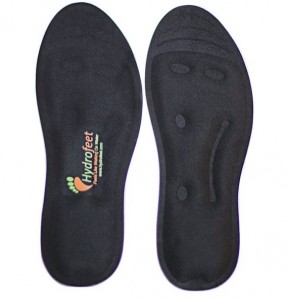 These insoles are perfectly filled with a dynamic vegetable-based glycerine to offer excellent support to the arch.
These insoles are perfectly filled with a dynamic vegetable-based glycerine to offer excellent support to the arch.
It supports your feet while providing cushioning, massage and an ever-changing surface for walking, standing or running.
They are perfect for people who experience sore tired feet, corns and calluses, back, knee and heel pain or poor circulation after extended periods of activity.
It provides cushioning by floating the foot off the shoe to anticipate impact thus allowing for a soft blow whenever the foot hits the ground.
Moreover, it alternates heel to toe pressure thereby creating a soothing effect that massages the foot and boosts blood circulation to all parts of the foot.
2. Best insoles for plantar fasciitis
FootActive Comfort
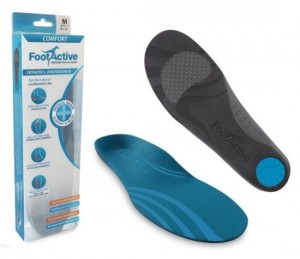 FootActive insoles are made from medium density, lightweight EVA with and cushioned with Durapontex to feature a deep heel cup, firm arch support as well as metatarsal support.
FootActive insoles are made from medium density, lightweight EVA with and cushioned with Durapontex to feature a deep heel cup, firm arch support as well as metatarsal support.
A full-length shock absorbing heel and top forefoot padding microfiber layer is added for extra foot function and increased comfort.
They are specifically designed to correct plantar fasciitis, over-pronation and fallen arches.
This premium insole works to restore normal foot utility by allowing joints and muscles to achieve full functionality.
Furthermore, it helps lower pressure on feet, knees and lower back allowing maximum ease and stability.
3. Best orthotic insoles
FootActive Medical
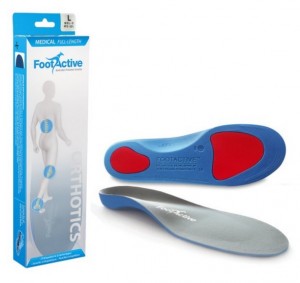 With Foot Active medical, you are assured of medical grade arch support for the treatment of severe foot pain, heel spurs, Achilles tendonitis and ball of foot pain.
With Foot Active medical, you are assured of medical grade arch support for the treatment of severe foot pain, heel spurs, Achilles tendonitis and ball of foot pain.
These insoles are specially made from high-density EVA, microfiber top layer and Durapontex cushioning.
This is to provide maximum forefoot padding as well as excellent shock absorbing.
Foot Active is the number one choice of orthotic insole for physiotherapists and podiatrists.
It works by realigning the foot and ankle through stabilisation of the heel and restoration of normal foot function to allow for comfort and efficiency.
4. Best insoles for high heels
Superfeet Delux High Heel
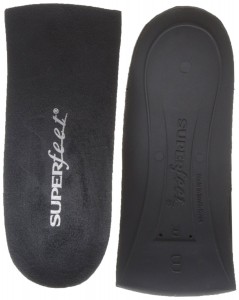 These three-quarter delux insoles are specially designed with a heel cup, stabilizer cap, slip resistant edges, micro suede top plush, and biomechanical shape.
These three-quarter delux insoles are specially designed with a heel cup, stabilizer cap, slip resistant edges, micro suede top plush, and biomechanical shape.
This is to provide proper support to all types of high-heeled shoes and boots.
They function by redistributing the weight and balance of the foot inside the shoe so you can feel comfortable throughout the day.
What is more interesting is the fact that these insole merges top orthotic inventions and designs to deliver a reputable level of comfort for any type of heel.
5. Best insoles for standing all day
Kaps Relax Gel Insoles
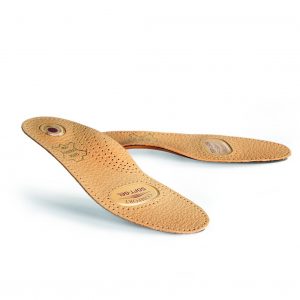 Relax gel insoles are perfect for people who endure long periods of standing all day.
Relax gel insoles are perfect for people who endure long periods of standing all day.
These dynamic insoles are constructed with genuine perforated skin to feature a middle layer made of latex, a correcting element to support the longitudinal arch of the foot and two gel inserts for the heel and the forefront.
The layer in contact with the foot absorbs sweat and eliminates unpleasant odour formed as a result of the sweating while the correcting element supports the entire length of the foot so as to increase stability.
The gel inserts serve the purpose of cushioning the shocks formed when both the forefoot and the heel hit the ground.
6. Best insoles for athletes
Superfeet Unisex Supportive Insole
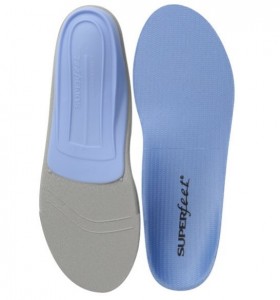 Designed primarily for athletic and casual footwear, these high-density insoles feature a deep heel cup, an anti-microbial coating, a stabilizer cap and a biomechanical shape for excellent performance.
Designed primarily for athletic and casual footwear, these high-density insoles feature a deep heel cup, an anti-microbial coating, a stabilizer cap and a biomechanical shape for excellent performance.
They have long-lasting support and come in different volumes to serve various purposes.
For instance, blue insoles are thinner in volume compared to green insoles and as such are more suitable for people with flat feet.
This is because there is far less foam volume in the arch thereby allowing maximum comfort without the added pressure.
Generally, superfeet insoles are perfect for most types of low and medium volume footwear as they occupy a limited amount of room in the footwear.
Note: Even though it takes time to adapt to the additional support provided by insoles, it is well worth the time when you consider its benefits in the long haul.
Frequently asked questions about foot insoles
Q: Which are the best shoe insoles for standing all day?
Look for shoe insoles/inserts designed mostly for comfort rather than support. They are made from very soft foam or gel. Sometimes the two are mixed together to create a soft gel foam.
Some insoles use glycerine, which conforms really well to your feet. This prevents pressure points especially under your heel and arches.
Comfort insoles provide soft cushioning that reduces pressure and strain on your feet when standing.
Q: Do foot insoles work?
You’d have to try them to see if they work for you.
But there is plenty of evidence that they work. They help reduce pressure and stain on feet for people who spend their day standing or walking.
They provide extra support for people with low or flat arches and they help with conditions like Plantar fasciitis, heel spurs and Achilles tendonitis.
How well a foot insole works depends on the type of insole you’ve chosen and your foot condition. But rest assured, the right insole makes a big difference.
Q: Which are the best insoles for flat feet?
If you have flat feet, you need insoles that prevent over pronation, cushion your feet when you are walking or running and provide adequate foot support.
Do not look for insoles that focus on arch support. These are not the best for flat feet. Look for those that support your entire foot and also provide cushioning from shock.
Q: Which are the best insoles for heel pain?
If you are experiencing heel pain, you need insoles that provide a good balance between support and comfort.
The first thing to check is the heel design. The insole should have a deep heel cup that keeps your heel in place.
This prevents heel slippage, which can worsen the pain.
The insole should also provide proper foot support, ensuring your heel doesn’t support all the weight.
Finally, the insole should provide soft cushioning from pressure and shock. This is especially important for athletes and people who spend most of their day standing or walking.
Q: Which are the best shoe inserts for high heels?
Look for inserts that provide extra support and cushioning to your metatarsal area. This is the area around your toes and the ball of the foot.
The right inserts should also keep your feet from slipping forward as you walk.
If you want support and cushioning along the length of your feet, look for full length heel insoles.
If you want support and cushioning for a specific part, you can find smaller pads for the toe area, heel or arch. Some insoles come in several pieces, allowing you to position them in the most comfortable positions.
Q: Which are the best insoles for knee pain and back pain?
If you are experiencing pain in your knees or back when you walk, it means your shoes are not providing adequate support and cushioning.
Look for insoles that support your heel, arch and toe area. They should also provide cushioning from shock and pressure.
Q: Can I wash insoles?
Yes, you can usually wash insoles to keep them clean and hygienic.
But check the specific washing instructions provided by the manufacturer. Some insoles may need careful handling to prevent damage.
You can wash most insoles in warm soapy water. Use a soft brush to scrub them clean. Rinse them in clean water and then leave them to dry overnight.
If your insoles are smelly, it’s because of bacteria. Disinfect the insoles by soaking them for a few hours in a mixture of water and vinegar.
Bottom line
Now that you are acquainted with typical footwear fit problems, be sure to purchase your own pair of insoles to give your feet proper cushioning and alleviate pain for a better healthier you!




